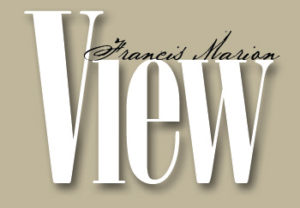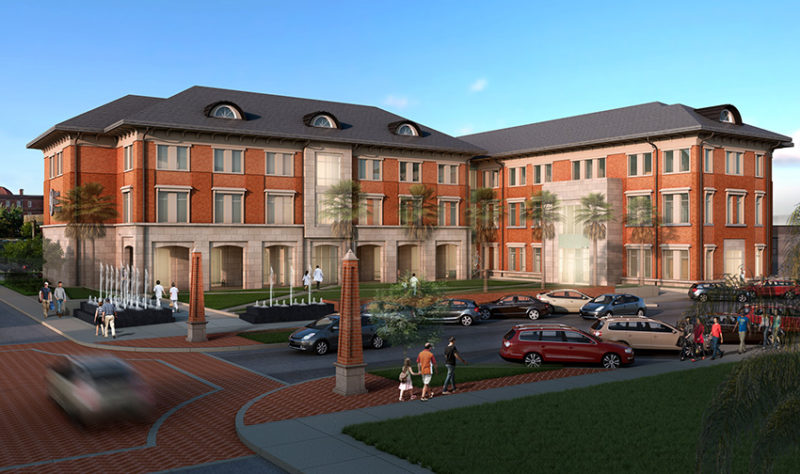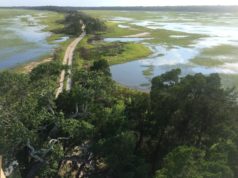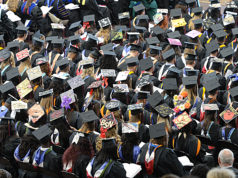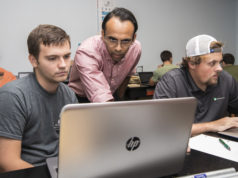Francis Marion University’s new Health Sciences Complex will transform place, people … and a university
When Francis Marion University’s Performing Arts Center opened in downtown Florence three years ago, it transformed the arts scene in the city and the surrounding region.
Two years from now, when the university’s new Health Sciences Complex opens a block and a half away from the PAC, the same sort of transformation is expected to overtake healthcare — and much more. University and community leaders believe the new building will re-shape everything from Florence’s status as a regional healthcare center, to the ongoing revitalization of the old downtown area, to the pivotal role FMU plays in the life of the community.
South Carolina Senate President Pro Tempore Hugh K. Leatherman, whose work as chair of the Senate Finance Committee paved the way for funding of the facility, called, the HSC “a game changer for Florence, Francis Marion University, and the Pee Dee.”
Florence Mayor Stephen J. Wukela says the HSC’s impact is so broad that it can be difficult to grasp.
“Whenever I start talking about it, I think I’m moving into hyperbole, but it’s really difficult to overstate the impact it will have. It’s going to affect the business, the culture and even the perception of downtown and of the city as a whole. … It’s a big, big deal.”
Says FMU President Dr. L. Fred Carter, “The impact is going to be enormous across a number of areas. It will enhance the visibility of the two large healthcare centers (McLeod Health and Carolinas Hospital Systems) as teaching hospitals, it will bring the City of Florence into the business of developing a major healthcare teaching center that will be second to none in this community. … And of course it’s a wonderful compliment to the university, too.”
Construction plans for the HSC are being finalized. University officials expect work on the building to begin in earnest in the Spring of 2015.
Old and new
The 50,000-square foot building, which will be situated on the southwest corner of Irby and W. Evans Street in the heart of downtown Florence, will be the heart of FMU’s rapidly expanding offerings in healthcare education. It is designed to serve an array of programs, both when it opens in the fall of 2016 and in the years and decades that follow.
FMU’s graduate-level programs in nursing (Family Nurse Practitioner, Nurse Educator), and its graduate level programs in Clinical Psychology will be housed at the HSC along with the new Physician Assistant program. That’s a real mix of old and new. The Psychology program dates to the late 1970s and is one of FMU’s foundational fields of study, for which it is rightfully known in the region and the state. But the FNP and Nurse Educator programs are new, having just graduated their first class in December, and the Physician Assistant program won’t enroll its first class until the fall of 2016, just as the HSC opens.
That gives some sense of the accelerating pace of FMU’s push into the healthcare education field, but even more is in the works. The regulatory process to bring a speech pathology and therapy program to the HSC is already underway, and planning has begun for new programs in physical therapy and healthcare administration.
Student appetite
The university has long provided high quality programming in the area of healthcare. The tempo picked up in the past decade plus, after FMU launched its own nursing program. FMU nursing piggybacked on the university’s well-respected programs in Psychology, Biology, Pre-Medicine and other sciences. A Health Physics course of study was added several years ago, introducing yet another facet of healthcare to the university’s academic offerings.
There’s a real appetite for these programs among students. The Department of Nursing, on the heels of graduating its first graduate-level class, is seeing enrollment in the follow-on classes grow, and university officials are already fielding calls from students interested in the Physician Assistant program two years before its scheduled to start.
All of that fits in neatly with Florence’s rise as a regional healthcare center, and the burgeoning need for healthcare providers in South Carolina, and especially within the Pee Dee.
Says Dr. Richard Chapman, FMU’s Provost, “We’re providing programs and careers that are needed in the community and which are attractive to students. We have a great base in liberal arts and sciences, but great professional degrees, especially in the healthcare care field, are going to be increasingly important for a variety of reasons.”
Carter says FMU will always be, at its core, a classic liberal arts university – a grounding in a core liberal arts curriculum is basic to every FMU degree, of course — but the natural growth of the institution means expanding into new areas. Healthcare is an obvious avenue for that expansion at FMU.
“There are already a lot of students who, when they think of FMU, will say, ‘it has great nursing and health sciences,’” says Carter. “We’re glad that’s happening, but we expect that to grow dramatically in the years ahead. … As we continue down the path of a comprehensive university, it’s great that students can pursue so many different academic goals. We don’t all have to drink from the same well.”
Besides the FMU programs, the HSC will also be home to 3rd- and 4th-year medical students from the University of South Carolina’s School of Medicine. The USC students will be completing their clinical rotations, a vital part of the med student’s instructional life, in Florence at McLeod and Carolinas hospitals. Classroom instruction accompanying the rotations, as well as administrative service for the students, will be headquartered at the HSC.
The USC students based in Florence represent the overflow from the available clinical positions in Columbia. The need for new clinical sites developed when the new Greenville-based medical college opened in 2013. Previously, some USC students did their clinical work in Greenville.
The Florence-based students will be in the Pee Dee by choice, having chosen their location based on geography, medical specialty, or other interests. Exploratory visits in the fall of 2013 demonstrated strong interest in the concept from the students, many of whom hailed from the region.
No small part of the decision to create a healthcare education center at FMU, and in Florence, was predicated on the desire to bring students to the area. Research shows that students who complete the medical training at a particular location are more likely to remain in that area, at least for the beginning of their career, if not beyond.
That will be true for the USC students, but it will be true for the FMU-trained Nurse Practitioners, Physician Assistants, Psychologists and other specialists in the years ahead as well.
Dr. C. Edward Floyd, chairman of the Drs. Bruce and Lee Foundation, one of the HSC’s funding partners, and head of the Floyd Medical Group, says the HSC will impact healthcare in the region for years to come because it will bring, and keep, need providers at home.
“That’s going to be the job of Francis Marion, of course, to find those men and women,” says Floyd. “But I have no doubt that this building, combined with the healthcare facilities we already have in this community, is going to do just that. It will have a profound impact.”
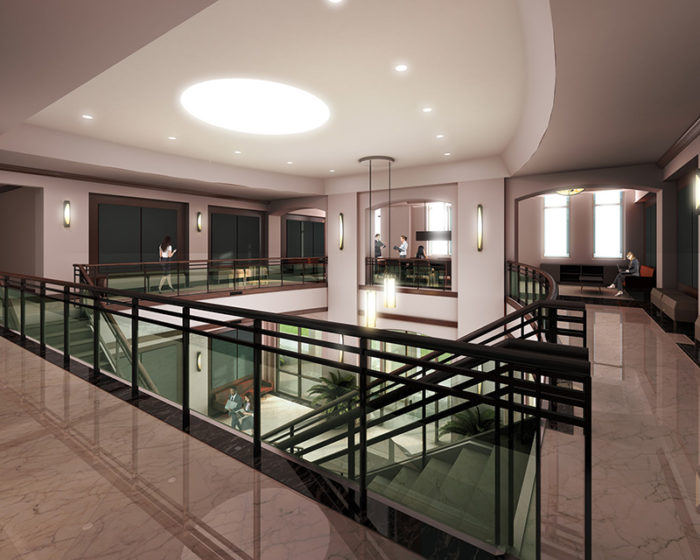
Six-year plan
Planning for the HSC, including a long period of consensus building, has been underway for nearly six years, says Carter. Francis Marion University officials, along with their community partners, began discussing the idea in 2009, just at the FMU Performing Arts Center, the university’s last big capital project, was coming out of the ground.
FMU’s Carter says that considering all that goes into a project of this scope, it’s remarkable that it moved along as quickly as it did.
“Putting together all these programs with all these partners, that’s fairly complex,” says Carter. “And then there’s the funding. It’s taken a lot of work. Fortunately, we’ve had a lot of good people willing to help.”
Operations at the HSC will be funded by Medicaid dollars, designed to help bring healthcare providers to the underserved rural areas. South Carolina as a whole is an underserved area, but under-resourced rural areas – most of the Pee Dee falls under that heading — suffer from particularly acute shortages. The Medicaid funding will total $9 million over five years.
To build the HSC, Carter assembled the same coalition that came together to fund the PAC. The Drs. Bruce and Lee Foundation, a Florence-based community foundation with strong healthcare ties, is contributing $7.5 million to the project. The state is contributing $5 million and the City of Florence is contributing $3 million. The project is engineered to stay within the $15.5 million budget, meaning, says Carter, that future health sciences students won’t be paying to retire debt in the building where they are being educated.
“As has been the case with all our recent projects,” says Carter, “this one will be paid for before we open the doors.”
FMU will oversee the basic administration and operation of the building. Individual programs will run their own shows inside, although one of the driving ideas behind the HSC is that the collaborative synergy of the partner programs will be helpful to all. Just what form that will take – classes involving students from more than one program, mentoring, special project partnerships – remains to be seen.
FMU officials haven’t named the overall building administrator. Dr. Ruth Wittmann-Price, the chair of FMU’s Department of Nursing, will oversee the graduate nursing programs. James “Chip” Hull, the recently named director of the PA program, will handle those duties. Dr. William “Bill” Hester of McLeod Health will oversee the USC medical students as the assistant dean of medical student education, Florence.
‘A new gateway’
The HSC’s 50,000 square feet will be spread across two floors. The building is L-shaped. It’s two wings will be connected by a striking, glass-enclosed atrium that will double as a an informal lounge area.
The working space will include more than a dozen classrooms, a half dozen labs, an auditorium, offices, informal gathering areas and the building’s signature instructional piece, a large simulation lab on the HSC’s third floor.
The simulation space will feature technology like what’s found in the Sim Lab at FMU’s Lee Nursing Building. There, computer-controlled mannequins are programmed to “complain” to student caregivers and exhibit a variety of symptoms. The HSC’s sim labs will expand on that model and will include consultation and exam rooms where aspiring healthcare providers can practice their future craft on mannequins, fellow students and even actors trained to display certain symptoms or create certain situations.
The building figures to be busy, with students and instructors from (at least) three programs scurrying from class to class during the instructional day, but because it will be such an elegant structure, in such a prominent place, it will likely serve other roles as well. The landscaped plaza in front of the building could easily become a regular site for university and community events. The existence of the plaza, and the manner in which it “communicates” architecturally with the surrounding buildings and streets, will almost surely transform the Irby-Evans intersection into the centerpiece of Florence’s revitalizing downtown.
Architect Thomas Carlson-Reddig of Charlotte-based Little Diversified Architectural Consulting, part of the team of architects involved in the design phase of the project, says the HSC will support the revitalization efforts already underway downtown by “offering a new gateway to the city at this important intersection. … It is a building that could only be of Florence.”
Just the beginning…
Although it is certainly not the main purpose of the HSC, the building and its programs will also contribute to the rejuvenation underway in downtown Florence. The building’s site was selected with that participation in mind. It will serve as both an anchor to the first phase of the downtown revitalization, and as a link to future phases that move further along Evans and Irby.
The presence of university buildings in the area offers both a physical and a psychological boost to the city’s efforts, says Wukela.
“When private developers look at that, hear about that, it gives them a confidence that almost nothing else can,” Wukela says. “Knowing that an institution like the university is committed makes all the difference in the world.”
Francis Marion University, of course, began life more than 50 years ago as the old Florence branch of the University of South Carolina. It was housed, in its early years, in the basement of the old public library, just a few blocks south of the site of the Health Sciences Complex.
Decades later, a downtown campus for the university is becoming a reality again. When the HSC is complete, FMU will have three buildings downtown – the HSC, the Performing Arts Center and the new FMU Recording Studio on Warley Street.
That’s three more than many could have imagined just a few short years ago, but it’s not, says Carter, the end of the line.
“I think it’s fair to say,” says Carter, “that this marks the beginning of FMU’s presence downtown, not the end.”
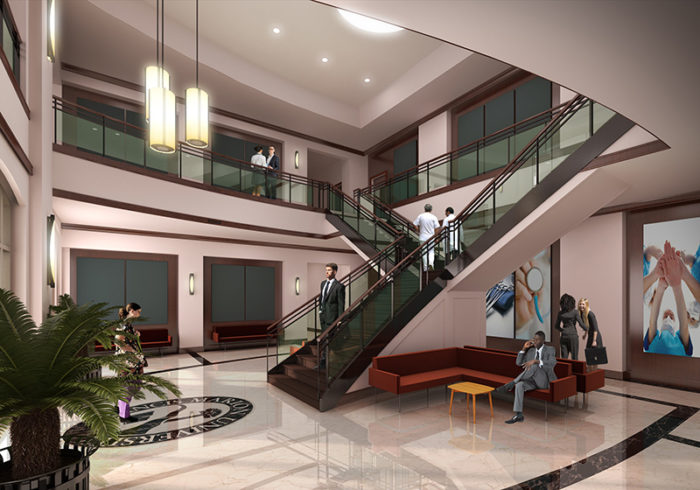
The HSC is ‘a big, big deal’
Several community leaders who played key roles in bringing the vision for Francis Marion University’s new Health Sciences Complex to life shared their thoughts on the project with the VIEW.
“Whenever I start talking about (the Health Sciences Complex), think I’m moving into hyperbole, but It’s really difficult to overstate the impact it will have. It’s going to affect the business, the culture and even the perception of downtown and of the city as a whole. And that’s leaving out the impact it will have for FMU as it continues to grow as an educational institution for this city and community. It’s a big, big deal.”
Stephen J. Wukela
Mayor of Florence
“It’s the most exciting project to come to Florence and the Pee Dee since I’ve been around here. Just thinking about all the possibilities, with all those students coming downtown, and all the great minds coming together in one facility from so many great institutions, it’s mind boggling really. We’ve got such great healthcare facilities in this community already, and now this. It’s going to change the face of the region for years to come.”
Dr. Eddie Floyd
Chair, Drs. Bruce and Lee Foundation
“The Health Science Complex is a game changer for Florence, Francis Marion University, and the Pee Dee. Medical students and instructors will be involved in our community by working in our hospitals, helping to treat our citizens and contributing to the positive growth of FMU and Florence. I am very pleased that we, as a team, have been able to plan for and fund this outstanding facility and program.”
Sen. Hugh K. Leatherman
President Pro Tempore, S.C. Senate, Chair Senate Finance Committee
